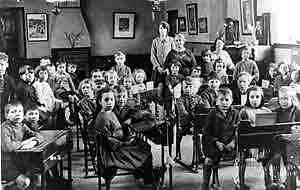Learning Spaces: Industrial to Information Age
 How important is the physical space in which learning occurs? "Learning spaces" has become not only a educational topic, but also a field along with learning space design and human-centered design.
How important is the physical space in which learning occurs? "Learning spaces" has become not only a educational topic, but also a field along with learning space design and human-centered design.
According an online EDUCAUSE eBook on learning spaces:
"The emergence of the constructivist learning paradigm has led to a focus on learning rather than teaching. It allows us to reevaluate classrooms and to consider informal learning spaces as loci for learning. If learning is not confined to scheduled classroom spaces and times, the whole campus—anywhere and at any time—is potentially an effective learning space... learning doesn't just happen in classrooms; learning also occurs outside the lecture hall. New strategies for enabling learning and accommodating the multiple demands on student time have led to rethinking the use, design, and location of learning spaces...
Space, whether physical or virtual, can have a significant impact on learning. Learning Spaces focuses on how learner expectations influence such spaces, the principles and activities that facilitate learning, and the role of technology from the perspective of those who create learning environments: faculty, learning technologists, librarians, and administrators. Information technology has brought unique capabilities to learning spaces, whether stimulating greater interaction through the use of collaborative tools, videoconferencing with international experts, or opening virtual worlds for exploration."
Can be that changes as simple as rearranging seating in a classroom can have a positive effect on learning? In Learning Transformed: 8 Keys to Designing Tomorrow’s Schools, Today, Sheninger and Murray discuss the transformation of physical spaces and how that affects pedagogy. Murray calls the typical desks in row model the “Cemetery Effect,” a design that goes back to the early 1900s.
More than a 100 years later, this industrial era model survives. Those classrooms of 100 years ago were preparing students to work in factories. Those students would become workers that probably spent their work day performing the same routine task, and often spent their entire career at the same company. That is not the current worker model, but classrooms frequently don't reflect any change.
Trackbacks
Trackback specific URI for this entryThe author does not allow comments to this entry
Comments
No comments